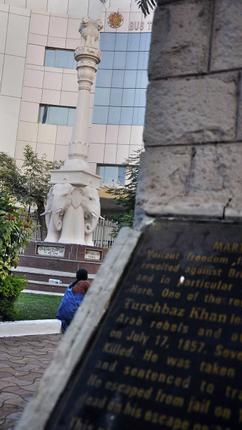The great patriot, however, remained unsung on January 24, which marks his 153rd death anniversary
The name of Turehbaz Khan conjures up images of valour and sacrifice. The name also puts Hyderabad on the map of the country’s First War of Independence or the Sepoy Mutiny of 1857. But how many of us know that January 24 marked the 153rd death anniversary of Turehbaz Khan, who, along with several others, rebelled against the English Resident, Major Cuthbert Davidson. The day simply passed off without a whimper.
It was in January 24, 1859, that many believe that Turehbaz Khan was killed in the forests of Toopran by the Talukdar, Mirza Qurban Ali Baig.
His body was brought to Hyderabad and according to several historical accounts was hung near the Residency, what is now Koti Women’s College, for public display and to act as a deterrent against any future rebellion.
Many in Hyderabad also do not know that the road in front of Osmania Medical College is named after Turehbaz Khan.
To mark the revolt of 1857, a memorial with the words ‘Memorial to the martyrs of July 17, 1857′ was constructed near Koti bus stand.
Even today, the name Turehbaz Khan is etched on the plaque.

The uprising was led by Turehbaz Khan and a fiery preacher, Maulvi Allauddin, along with 500 Rohillas, who were of Pashtun (Pathan) stock.
Unequal fight
Essentially, the revolt was to free Jamedar Cheeda Khan, who was held in the prison inside the Residency. The 500 Rohillas tried to storm the Residency under the direction of Turehbaz Khan and Maulvi Allauddin, who controlled the revolt by occupying the houses of two local moneylenders, Abban Saheb and Jaigopal Das.
Historians point out that the fight between the Rohillas and British troops, who were led by Major S. C. Briggs, continued throughout the night. Apparently, Salar Jung alerted the British about the impending revolt. The British troops were prepared and waiting for Khan to attack.
Needless to say, the Rohillas, who wielded swords, were outclassed by trained British soldiers who opened fire on them. By morning the rebellion was crushed.
Shot dead
Many armed men who took part in the revolt were caught and sent to prison. Among them was Turehbaz Khan, who received a life sentence. However, the canny Turehbaz Khan managed to escape from prison on January 8, 1859.

Immediately after the escape, the British authorities offered a reward of Rs. 5,000 to anyone who could apprehend Turehbaz Khan.
Within a few days, many believe that it was on January 24, 1859, when Turehbaz Khan was shot in the forest of Toopran by Talukdar Mirza Qurban Ali Baig. As a reward, the Talukdar received Rs. 5,000 and his salary was also raised by Rs. 200.
He was also promoted as Sadar Talukdar, say historical accounts.
________________________________________________________________________
- Many believe it was on Jan. 24, 1859, that Khan was killed in Toopran forest by Qurban Ali Baig
- Khan’s body was hung near the Residency to act as a deterrent against any future rebellion
- ___________________________________________________________________
source: http://www.thehindu.com / The Hindu / Home> National> Andhra Pradesh / by M. Sai Gopal / Hyderabad – January 27th, 2012








